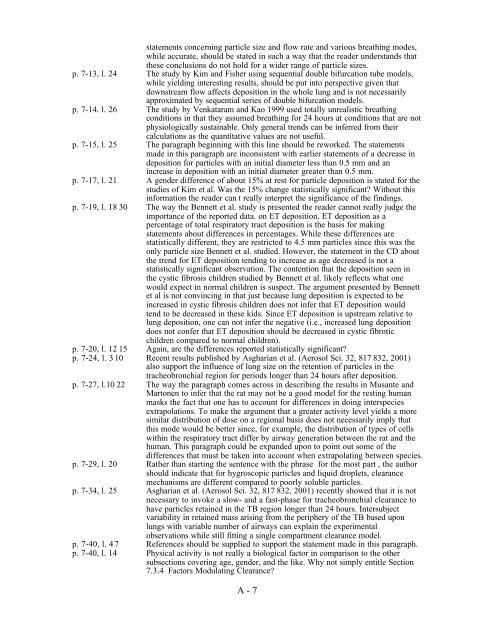Review of the Air Quality Criteria Document for Particulate Matter
Review of the Air Quality Criteria Document for Particulate Matter
Review of the Air Quality Criteria Document for Particulate Matter
- No tags were found...
Create successful ePaper yourself
Turn your PDF publications into a flip-book with our unique Google optimized e-Paper software.
statements concerning particle size and flow rate and various breathing modes,while accurate, should be stated in such a way that <strong>the</strong> reader understands that<strong>the</strong>se conclusions do not hold <strong>for</strong> a wider range <strong>of</strong> particle sizes.p. 7-13, l. 24 The study by Kim and Fisher using sequential double bifurcation tube models,while yielding interesting results, should be put into perspective given thatdownstream flow affects deposition in <strong>the</strong> whole lung and is not necessarilyapproximated by sequential series <strong>of</strong> double bifurcation models.p. 7-14. l. 26 The study by Venkataram and Kao 1999 used totally unrealistic breathingconditions in that <strong>the</strong>y assumed breathing <strong>for</strong> 24 hours at conditions that are notphysiologically sustainable. Only general trends can be inferred from <strong>the</strong>ircalculations as <strong>the</strong> quantitative values are not useful.p. 7-15, l. 25 The paragraph beginning with this line should be reworked. The statementsmade in this paragraph are inconsistent with earlier statements <strong>of</strong> a decrease indeposition <strong>for</strong> particles with an initial diameter less than 0.5 mm and anincrease in deposition with an initial diameter greater than 0.5 mm.p. 7-17, l. 21 A gender difference <strong>of</strong> about 15% at rest <strong>for</strong> particle deposition is stated <strong>for</strong> <strong>the</strong>studies <strong>of</strong> Kim et al. Was <strong>the</strong> 15% change statistically significant? Without thisin<strong>for</strong>mation <strong>the</strong> reader can t really interpret <strong>the</strong> significance <strong>of</strong> <strong>the</strong> findings.p. 7-19, l. 18 30 The way <strong>the</strong> Bennett et al. study is presented <strong>the</strong> reader cannot really judge <strong>the</strong>importance <strong>of</strong> <strong>the</strong> reported data. on ET deposition. ET deposition as apercentage <strong>of</strong> total respiratory tract deposition is <strong>the</strong> basis <strong>for</strong> makingstatements about differences in percentages. While <strong>the</strong>se differences arestatistically different, <strong>the</strong>y are restricted to 4.5 mm particles since this was <strong>the</strong>only particle size Bennett et al. studied. However, <strong>the</strong> statement in <strong>the</strong> CD about<strong>the</strong> trend <strong>for</strong> ET deposition tending to increase as age decreased is not astatistically significant observation. The contention that <strong>the</strong> deposition seen in<strong>the</strong> cystic fibrosis children studied by Bennett et al. likely reflects what onewould expect in normal children is suspect. The argument presented by Bennettet al is not convincing in that just because lung deposition is expected to beincreased in cystic fibrosis children does not infer that ET deposition wouldtend to be decreased in <strong>the</strong>se kids. Since ET deposition is upstream relative tolung deposition, one can not infer <strong>the</strong> negative (i.e., increased lung depositiondoes not confer that ET deposition should be decreased in cystic fibroticchildren compared to normal children).p. 7-20, l. 12 15 Again, are <strong>the</strong> differences reported statistically significant?p. 7-24, l. 3 10 Recent results published by Asgharian et al. (Aerosol Sci. 32, 817 832, 2001)also support <strong>the</strong> influence <strong>of</strong> lung size on <strong>the</strong> retention <strong>of</strong> particles in <strong>the</strong>tracheobronchial region <strong>for</strong> periods longer than 24 hours after deposition.p. 7-27, l.10 22 The way <strong>the</strong> paragraph comes across in describing <strong>the</strong> results in Musante andMartonen to infer that <strong>the</strong> rat may not be a good model <strong>for</strong> <strong>the</strong> resting humanmasks <strong>the</strong> fact that one has to account <strong>for</strong> differences in doing interspeciesextrapolations. To make <strong>the</strong> argument that a greater activity level yields a moresimilar distribution <strong>of</strong> dose on a regional basis does not necessarily imply thatthis mode would be better since, <strong>for</strong> example, <strong>the</strong> distribution <strong>of</strong> types <strong>of</strong> cellswithin <strong>the</strong> respiratory tract differ by airway generation between <strong>the</strong> rat and <strong>the</strong>human. This paragraph could be expanded upon to point out some <strong>of</strong> <strong>the</strong>differences that must be taken into account when extrapolating between species.p. 7-29, l. 20 Ra<strong>the</strong>r than starting <strong>the</strong> sentence with <strong>the</strong> phrase <strong>for</strong> <strong>the</strong> most part , <strong>the</strong> authorshould indicate that <strong>for</strong> hygroscopic particles and liquid droplets, clearancemechanisms are different compared to poorly soluble particles.p. 7-34, l. 25 Asgharian et al. (Aerosol Sci. 32, 817 832, 2001) recently showed that it is notnecessary to invoke a slow- and a fast-phase <strong>for</strong> tracheobronchial clearance tohave particles retained in <strong>the</strong> TB region longer than 24 hours. Intersubjectvariability in retained mass arising from <strong>the</strong> periphery <strong>of</strong> <strong>the</strong> TB based uponlungs with variable number <strong>of</strong> airways can explain <strong>the</strong> experimentalobservations while still fitting a single compartment clearance model.p. 7-40, l. 4 7 References should be supplied to support <strong>the</strong> statement made in this paragraph.p. 7-40, l. 14 Physical activity is not really a biological factor in comparison to <strong>the</strong> o<strong>the</strong>rsubsections covering age, gender, and <strong>the</strong> like. Why not simply entitle Section7.3.4 Factors Modulating Clearance?A - 7
















